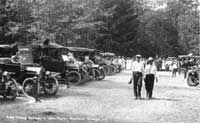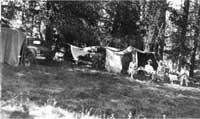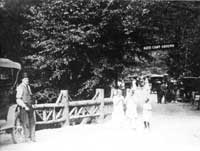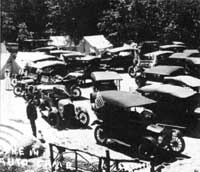The Redwood Highway connected Grants Pass with Crescent City in 1926, and anew route to Crater Lake from Medford was completed in 1927. These new roads and an improved Pacific Highway between Drain and Wolf Creek (which had been described in 1917 by Sunset Magazine as rough at all times and impassable in wet weather) allowed entrepreneurs to build camps with cabins at strategic points to lure the long-distance tourist. Since a cabin could be built for two hundred dollars or less, an owner’s investment could be paid off in a season or two. [9]
Whether the commercial camps were located in the vicinity of a town or on the highway many miles from a business district, the cabins tended to be arranged in a row parallel or perpendicular to the highway. [10] One of the few differences between city and rural commercial camps was that the latter more often included a gas station and/or store as part of the operation. During this period, “kitchenettes” were often provided in the cabin, but showers and toilets could be found in a central bathhouse. [11]
 Lithia Park’s grounds were well used if the cars lined up here are any indication. Lithia Park auto camp grounds in Ashland, July 1931
Lithia Park’s grounds were well used if the cars lined up here are any indication. Lithia Park auto camp grounds in Ashland, July 1931
Courtesy Southern Oregon Historical Society #15985
 Left to right: Minnie Lane, Mr. and Mrs. Pernell Whitmore, Jessie Stone holding “Skippy” and Clarence Lane holding “Patsy” all camping at Diamond Lake. July 1931;Courtesy Southern Oregon Historical Society #15984
Left to right: Minnie Lane, Mr. and Mrs. Pernell Whitmore, Jessie Stone holding “Skippy” and Clarence Lane holding “Patsy” all camping at Diamond Lake. July 1931;Courtesy Southern Oregon Historical Society #15984
The first U.S. Forest Service campground was established in 1915 (along Eagle Creek in the Columbia River Gorge) and their number nationwide grew to fifteen hundred by 1923. [12] These campgrounds soon became an important component to outdoor recreation in the Pacific Northwest because over one-third of the region was national forest. Forest Service camp sites consisted of parking space for a car, a level area for tents, and a picnic table. The campground’s community pump provided drinking water, and one or two pit toilets served as sanitation. Like the early municipal camps, there was no charge for use of the facilities.
By 1935, auto camping widened to include what were originally called “trailer houses.” Trailers allowed the motorist to literally carry a dwelling to a camp site. Their appearance generally coincided with the development of cottage courts and motor inns, so that the modern range of accommodation for travelers was clearly discernible in 1940.
Availability of funds and labor for campground development through the Civilian Conservation Corps (CCC) program coincided with the trailer’s increasing popularity. Some camp sites were modified to accommodate this new type of auto camping despite a protest from one prominent campground designer stating that trailers were detrimental to “the camp spirit,” as contrasted with city, and town life. [13] Lithia Park attracted tourists with amenities like mineral water, a community house with gas stoves, a nearby grocery store, and even a laundry wagon. ca 1916
Lithia Park attracted tourists with amenities like mineral water, a community house with gas stoves, a nearby grocery store, and even a laundry wagon. ca 1916
Courtesy Southern Oregon Historical Society #15987
 People flocked to the auto campground for the dedication of Lithia Park in Ashland, July 1916
People flocked to the auto campground for the dedication of Lithia Park in Ashland, July 1916
Courtesy Southern Oregon Historical Society #15986
Nevertheless, a number of parking spurs to accommodate trailers were eventually placed in many of the region’s Forest Service campgrounds. Few of the conversions were as dramatic as the metamorphosis of the Sucker Creek Forest Camp, located near Milepost 12 of the Oregon Caves Highway. A nearby CCC camp began work in late 1934 to make the campground suitable for trailers because of the gradient of the road beyond that point. It was renamed “Grayback Campground,” and the CCC began to construct new campsites which had larger vehicle parking space. Other projects there included a massive landscaping program to remove traces of the old campground; new fireplaces: and construction of a community building like those in the municipal auto camps.

